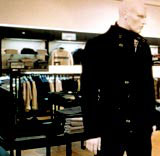Harrods
Designed by: Corsie Naysmith

Designed by: Corsie Naysmith
By the end of this year the first phase of Harrods’ 3300m2 ground floor modernisation strategy will be completed. As part of this programme, Harrods wanted to energise its menswear offer; to accomplish this it brought in consultants to design a new ground floor department for the first time in 15 years.
International retail design consultant Corsie Naysmith is undertaking the work, following its creation of a designer menswear department in the department store’s basement. The ground floor programme takes in classic menswear, knitwear, leather accessories, casualwear and footwear. Since the opening of the latter department before Christmas, Harrods has seen a 30 per cent increase in footwear trading.
According to Corsie Naysmith marketing manager Stephen Cribbett, the key to the design strategy for menswear is the seamless integration of the fashion brands within the overall scheme. The ground floor takes in names such as Polo Ralph Lauren, Tse, Pringle, Ballantyne and Holland & Holland, while the basement area, which opened two years ago, comprises 14 brand islands managed by Harrods with concessions from fashion labels such as Gucci, Jil Sander and Georgio Armani.
‘It is important in retail to balance the design vision of the overall scheme with the density of products that need to be displayed on the shopfloor in order for the retailer to continue hitting its targets,’ Cribbett explains. ‘You need to work closely with the retailer’s buyers and also with the individual designers of concession areas,’ he adds.
On the ground floor, the brief was to retain the building’s existing architectural features such as the original moulding, walkways and columns. Corsie Naysmith has juxtaposed traditional materials such as English oak and gilding with modern elements such as glass and lacquer-finished Wenge display systems.
‘In design schemes such as this you need to have a specific understanding of the mechanisms that take place in the store environment,’ says Cribbett. ‘You need to know the relationship with the back of house, how stock is brought into the store and you need to build in flexibility. Department stores are constantly bringing in new brands and the retail system needs to be able to display different types of product and accommodate different visual merchandising strategies,’ he adds.
This has been particularly apparent in the basement, where Corsie Naysmith developed 65 module systems for wall panels. The consultancy worked closely with the designer brand owners to ensure that they understood what Harrods was looking for in terms of ambience and its own brand positioning.
‘It was important that the individual brands could merchandise themselves in line with their own brand image, while fitting in as seamlessly as possible within Harrods’ overall design,’ says Cribbett. ‘They could not be kings and queens sitting within the store look.’
Since turning the basement area from a stockholding area to a retail space, Harrods has seen a 44 per cent increase in profits and increased operating margins from both the brands and product lines located in the department. It will be hoping for the same results from the rest of the design programme.
-
Post a comment




